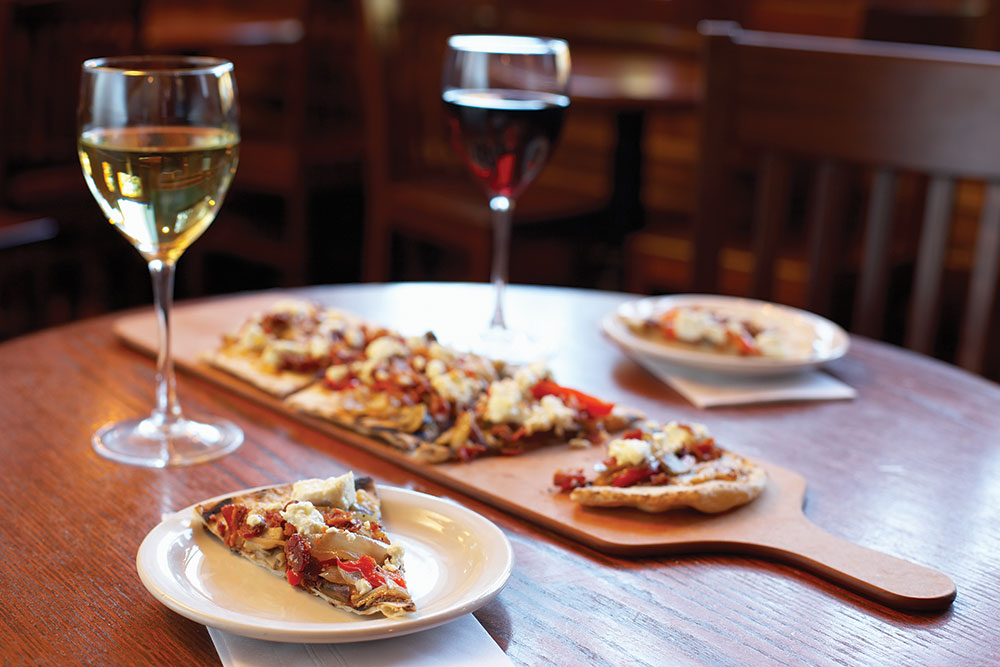- The classic match for a New York-style pizza is a fairly fresh, lighter-bodied wine with good acidity, like Barbera or Chianti Classico.
- For a thicker-crust Chicago-style pizza, you’ll want to point your customers to a more full-bodied wine.
Related: Italian experts share their favorite pizza-wine pairings
Beer may still be the pizza lover’s go-to beverage, but wine is fine, too, for many customers. Unfortunately, they often don’t know how to select the right wine for their pizza. Educating your customer on this subject can lead to higher wine sales, but pairing wines and pizzas can be a tricky business.
For starters, pizzas come in a vast range of styles, from the light and thin examples inspired by Naples to the deep-filled Chicago style and everything in between. Pizzas also vary hugely in quality, and the variety of toppings is pretty much endless—any combination you settle on will introduce an entirely new set of flavors. That means there are no hard and fast rules for pairing pizzas with wines, but we can offer some pointers to keep in mind.
The New Yorker
For starters, let’s talk about the New York style of pizza, with a thin sourdough-type base, a bit of charring and a slightly chewy texture, plus tomato sauce and cheese. The classic match for this style of pizza is a fairly fresh, lighter-bodied wine with good acidity. Barbera or Chianti Classico would be ideal, but anything along those lines will do. Ideally, you’re looking for something with a savory edge that’s easy to drink—with all that good pizza saltiness, your customer will want to glug the vino and still feel refreshed rather than have to chew through a mouthful of heavy wine.
Once you move away from the standard New York style, though, things get a little more complicated—and challenging. Let’s look at some more possibilities.
Matching by Style
Earlier, we mentioned two extreme styles as examples: the hearty, robust Chicago style and the thinner Neapolitan crust. A thicker-crust Chicago pizza, generally speaking, is a much richer, denser pie with a lot more of everything—cheese, tomato, base and so on. Accordingly, you’ll want to point your customers to a more full-bodied wine, but, at the same time, freshness and acidity are still important; otherwise, it will all become a bit too much for your guest. For this type of pizza, consider a Zinfandel, a Cabernet from a cooler climate or perhaps something from or inspired by the northern Rhône—a Syrah or Shiraz, perhaps, with a touch of Viognier.
With the thinner Neapolitan style, you’ll be looking for something more delicate. A fresh, crisp white wine, such as a Soave or Sauvignon Blanc, would be good, or you may want to think about a soft, fruity red wine such as Pinot Noir or Gamay. Of course, when the crust is thinner and the tomato sauce and cheese are layered on with less thickness, your guest’s chosen topping, whatever it may be, is the more dominant flavor. And that’s where matching wine with specific ingredients comes in.
Related: How to create your own pizza and wine pairing soirée
Matching by Ingredient
When your pizza is really just a vehicle for one or two star ingredients and you’re looking for a special wine match, it’s wise to think about what goes best with that particular topping’s flavor. We can’t cover every possibility in a single article, of course, but here are a few examples of common pizza toppings to get you started:
- Anchovies—Strong and salty, an anchovy pizza needs to be paired with something robust, but it can be red, white or rosé. A Rioja Crianza would be ideal.
- Cheese (other than mozzarella)—Contrary to popular belief, in most cases you will probably be better off with a white wine than a red one. For creamy cheeses, look for something with good acidity—Sauvignon Blanc works very well with goat cheese, for example. For blue cheeses, try introducing a touch of sweetness. Depending on how dominant the cheese is, something medium or even sweet would be interesting.
- Ham or prosciutto—In the red department, go for something light and fruity, such as Beaujolais. However, the best choice here is a fuller, richer white, such as Pinot Gris from Alsace or Grüner Velliner.
- Mushrooms—For this kind of featured topping, you’ll want to go for something red and earthy. Burgundy or Reserva Rioja are the obvious choices.
- Pepperoni—This one can be tricky due to the spice level of the pepperoni. Something dry and white is probably best, such as a full-bodied, dry Riesling.
When advising your guests about wine-and-pizza pairings, keep in mind that much of the dining experience comes from context, so the customer’s mood should be taken into consideration. If it’s dark and rainy outside and the customer has ordered a carryout pie, a full-bodied red might be the most appropriate choice, regardless of the style or topping. On the other hand, a bright, warm, sunny day may be the perfect time for a nice glass of rosé!
The good news is that pizza is quite versatile, so there is no one right answer. And customers should be made to understand that it’s perfectly OK to watch their wallets when pairing wine with pizza. Unless you’re serving gourmet pizza, it’s not necessary to go the expensive route. Pizza is an everyday food, and it calls for an everyday wine!













